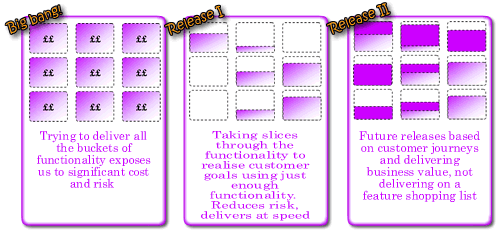The product is irrelevent. It’s the customer experience that pays the bills
Why do organisations exist? To make money. In corporateSpeak “to add shareholder value”.
Where does money come from to deliver shareholder value? Customers.
Many organisations seem to forget this slight detail. It gets lost in the internal machinations and politics.
Why do individual funcitons exisit within an organisation? Marketing, product development, IT, sales, operations… None of these add shareholder value make money in themselves. Yet in all too many organisations these different functions behave as if they exist for themselves, they are entities unto themselves. Each entity may pay lip service to the “customer” but how joined up is the reality?
How familiar is this.
The product team identify the need for something, based on anecdotes from the sales guys, or something they perceive to be wrong with the existing product or a hunch about a potential niche in the market. A niche in the market but is there a market for that niche? A bunch of requirements are written up and an optomistic benefits case is written up. There are x million widget users in the market place. Y% of these would benefit from NewGizmo. We project 10% of these will buy at a price point of £z. The requirements are thrown over the wall to IT to put some development costs on the project. The project has yet to start and a launch date is set in stone. And a project manager has yet to be assigned. Marketing are brought into the picture and tasked with how are we going to sell the product. Development starts (the new project manager is aghast at the scope and timescales he is inheriting). Operations enter the project and throw water on the fire. There a whole bunch of compliance and business as usual considerations that only now come to light. Relationships become tense as the project manager tells the product team that they can’t have what they want by the date they wanted it. The date has been set in stone, so the product team throw out some of the initial requirements, based upon an argumentative workshop on Thursday afternoon (noone bothers to refer back to the initial benefits case, even less any thought of how their decisions impact the overall customer experience). And inevitably a cut down NewGizmo is launched to the market a month late and sales are nowhere near what was projected. What we need is NewGizmo 2.0 and so the cycle starts again…
What if we put the customer at the heart of the organisation. What if everything we do is motivated by serving the customer? What if we forget all about our products and focussed upon what our customers’ need and how we can delight them. What if the products become an enabler to a compelling customer experience, rather than an end in themselves?
Isn’t shareholder value all about generating revenue? Isn’t revenue driven from customers? Aren’t customers driven by compelling experiences rather than mediocre hassle?


